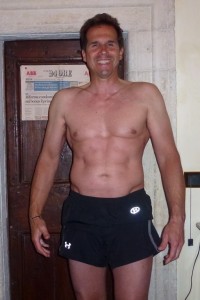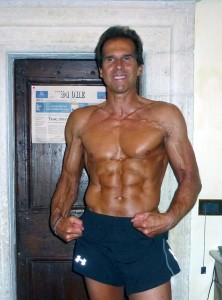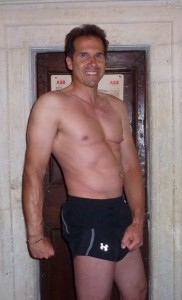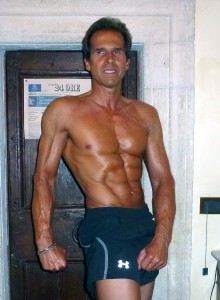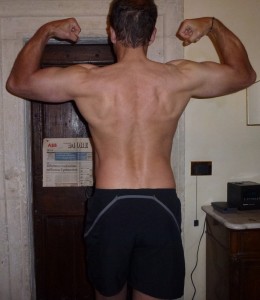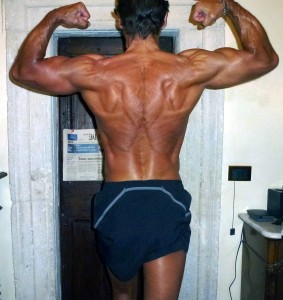Titolo: Lesione Del Legamento Crociato Anteriore (LCA) e Operazione Di Ricostruzione: La Mia Esperienza
Autore: Piero Maina
Conteggio Parole: 2.934
Ciao a tutti, è un po’ che non scrivo e di solito negli ultimi tempi ero solito raccontare le novità nel campo del fitness e della forma fisica o della scienza dell’alimentazione o le novità in vista della preparazione a gare di fitness, ma ahimè, il giorn0 11 gennaio 2014 mi sono infortunato malamente sciando e ho riportato la lesione con rottura completa del legamento crociato anteriore (LCA), rottura del menisco mediale, compromissione del legamento crociato posteriore, compromissione del legamento collaterale mediale e frattura del piatto tibiale posteriore nel ginocchio sinistro. Beh, non male! La caduta non è stata rovinosa, nel senso che non ho fatto capriole con gli sci attaccati ai piedi, ho preso un’ “internata” e invece di scivolare via o di rimanere in piedi sullo sci interno, come di solito può accadere, forse a causa del fondo con neve artificiale, gli sci sono partiti verso monte e io mi sono sdraiato sulle code con il sedere attaccato agli scarponi e le ginocchia in alto e ho cercato di contrastare la caduta, anche perché stavo per dare il “giro”, come si dice in gergo e quindi mi aspettavo il peggio. Invece dopo una quarantina di metri fatti con la schiena sulla neve, sono riuscito a recuperare e a tornare in piedi, ma il legamento crociato anteriore non c’era più. Ho terminato la pista 200 mt. sotto sulle mie gambe, ma sentivo oltre al dolore, che qualcosa era successo, mi sentivo come ubriaco e non capivo veramente niente. Era la prima discesa della giornata del primo giorno della settimana bianca che ero andato a fare per allenarmi, ma arrivavo da dieci giorni sciati fino alla settimana precedente ed in formissima fisicamente e atleticamente, oltre ad essere un bravo sciatore con un passato di gare e che ancora si allena sugli sci. E’ vero che gli sci non rispondevano su quel fondo artificiale ed essendo la prima discesa, forse avrei fatto bene a scendere più tranquillo, ma la pista non aveva gobbe o altro, ho padronanza degli sci visto che scio da oltre quarant’anni ed è inutile andare a fare analisi post incidente, doveva succedere, è successo e ora si guarda avanti cercando di recuperare ginocchio e forma al meglio e prima possibile. Tornando al dopo incidente, oltre a pensare che quello che era successo aveva del grottesco, per il modo e la gravità, non volevo pensare al peggio. Ho chiamato un mio amico che avevo appena lasciato in cima alla pista, dicendogli che mi ero fatto male seriamente, ma che ero in piedi e l’avrei raggiunto alla telecabina per scendere a valle e di aspettarmi alla partenza. Nel frattempo ho provato a spingere le tibie sul linguettone degli scarponi e vedevo che stavo in piedi, ma se provavo a fare dei passi, mi sentivo “strano”, ancora non sapevo. Quando ho provato a rimettere gli sci e ho dato pressione sulle talloniere, la gamba sana non ha avuto problemi, mentre quando ho dato pressione con la gamba infortunata, ho avvertito una sensazione spiacevolissima che non scorderò mai più, la tibia è andata da una parte e il femore dall’altra; terribile! Ho chiamato subito il mio amico dicendo che era impossibile raggiungerlo e da lì sono arrivati quelli del soccorso. La diagnosi è quella che ho scritto sopra e la mia settimana bianca è durata 10 minuti. Settecentocinquanta chilometri di viaggio per mezza pista, e altrettanti per tornare indietro la mattina dopo e grazie al fatto che la gamba infortunata era la sinistra e ho il cambio automatico, sono riuscito a rientrare guidando da solo. Questo il racconto sul come, adesso vediamo cosa è successo una volta rientrato a Roma.
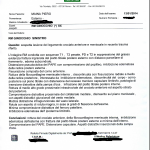
Ho effettuato la visita ortopedica che naturalmente ha evidenziato alle prove manuali quello che avevo avvertito rimettendo gli sci e che era già stato riscontrato al pronto soccorso di Brunico. Confermato poi dalla RMN con il referto che ho postato sopra e che metto in originale qui a fianco nella foto. Vista la situazione del mio ginocchio, abbiamo rimandato l’operazione di dieci giorni, anche per fare riassorbire in parte l’edema e vedere come rispondeva il ginocchio. Ho indossato un tutore post operatorio Don Joy e ho aspettato la settimana seguente. Visita lunedì 20 gennaio 2014 e operazione confermata per giovedì 23 gennaio 2014. Visto il fatto che sono ancora un atleta in attività, il mio ortopedico che è il Dr. Prof. Attilio Rota, primario del reparto ortopedia dell’ospedale Sandro Pertini di Roma, mi ha comunicato che pensava di operarmi utilizzando per la ricostruzione dell’LCA, il tendine rotuleo, in funzione della sua esperienza ventennale e che ancora preferiva per atleti che sottopongono a grossi carichi il ginocchio. Ma mi disse anche che in sede di operazione, se non avesse ritenuto le condizioni idonee, avrebbe utilizzato la tecnica di ST (Semitendinoso) + Gracile che oltretutto presenta alcuni pro rispetto al rotuleo. E questo è avvenuto. Non ha ritenuto ideale la situazione e ha preferito ricostruire utilizzando ST + G. Oltretutto ho i tendini molto grossi e quindi è molto soddisfatto, infatti mi ha detto che ha usato per bucare tibia e femore una punta del 10 e ha poi messo viti dell’11 e mi dice che non capita molto spesso. Mediamente utilizza viti dell’8 e 9 e nei casi maggiori del 10. Ho potuto vedere l’operazione dalla chiavetta USB che mi ha dato e in effetti il ginocchio ha preso una brutta botta e questa è una situazione di partenza più invalidante rispetto a chi arriva con la sola rottura dell’LCA , inoltre sono stato operato anche al menisco mediale.
Ora vi racconto com’è andata, di modo che possiate trovare informazioni utili:
Mi sono operato la mattina del 23 gennaio e mi sono presentato in clinica alle 7 e 30 a digiuno, avevo già effettuato gli esami del sangue e l’elettrocardiogramma lunedì 20 e così ho risparmiato tempo. Espletate le operazioni amministrative (mi sono operato in clinica perché assicurato), mi hanno accompagnato in camera, non ho avuto bisogno di depilazione perché avevo già le gambe depilate, ma la prassi per chi ha i peli è di vedersi depilare la gamba. E’ entrato il dottore verso le 8 e 30 e mi ha fatto le solite domande di rito su malattie pregresse, fratture, operazioni, etc. Alle 9 mi hanno portato in sala operatoria e hanno cominciato a farmi l’anestesia, hanno utilizzato l’anestesia locale con tecnica bi-block, addormentandomi la sola gamba, dal piede all’inguine. Sensazione molto strana, perché iniziano dal polpaccio ed è come utilizzare un elettrostimolatore per trovare i nervi. (chi ha già provato, conosce la sensazione) Dolore sopportabile all’inserimento dell’ago, ma si avverte un primo dolore che diminuisce mano, mano. Poi procedono con una puntura dall’inguine, sempre con la stessa procedura delle contrazioni muscolari e poi una nel gluteo e la gamba comincia ad addormentarsi. Mi hanno dato anche un altro sedativo che mi ha mezzo rimbambito e sono entrato in sala operatoria verso le 9 e 20. La gamba era addormentata, ma io sentivo senza dolore apparente (anche se non vedevo niente perché avevo un telo davanti), tutti gli strumenti che mi toccavano il ginocchio e poi le “manovre” che mi venivano praticate che se non avessi avuto la gamba anestetizzata, probabilmente mi avrebbero fatto provare dolori inenarrabili. Alle 9 e 30 è iniziata l’operazione e io potevo vedere il mio ginocchio dal monitor, ma mi sentivo veramente rimbambito dall’anestesia che mi avevano dato oltre alla “locale” nella gamba e “sentivo” il lavoro all’interno. Così hanno deciso di addormentarmi completamente e mi sono perso il resto dell’operazione. Come ho scritto sopra, è stato utilizzato il Semitendinoso e il Gracile quadruplicato e i miei tendini donati sono molto grossi. Avevo chiesto al mio ortopedico Dr. Attilio Rota, cosa ne pensasse della donazione da cadavere, ma lui me l’ha sconsigliato, così come il tendine artificiale LARS. Lui non li utilizza, né lo utilizzano il 90% dei chirurghi al top nel mondo e quindi lui non era e non è disposto ad operare diversamente. E’ uno specialista del ginocchio e compie ricostruzioni del crociato al ritmo di 100/150 crociati all’anno da vent’anni e credo quindi che abbia l’esperienza per parlare. Alle 11 e 40 sono rientrato in camera. Mi sono risvegliato da subito e avevo il tutore bloccato completamente a zero gradi, la gamba era totalmente addormentata e avevo l’antidolorifico che attraverso la flebo faceva il suo dovere. Il contenuto era toradol più morfina ed è durato circa 30 ore. Mi hanno somministrato sempre tramite flebo un antibiotico ogni 12 ore. La prima notte è stata pesantuccia, la gamba ha cominciato a risvegliarsi partendo dal piede poco dopo la mezzanotte e naturalmente dormire non è stato semplice, visto che sono abituato a dormire sul fianco, ma qui era impossibile. Dovevo dormire supino, sulla schiena, ma ogni tanto dovevo spostarmi per far respirare glutei e schiena e in quel caso il ginocchio si faceva sentire. Sentivo sia il peso delle lenzuola sui piedi che il dolore nella parte posteriore della gamba, nella zona dove erano stati prelevati i tendini per la ricostruzione del neo legamento. Dolori presenti, ma sopportabili. Considerate che dalla mattina successiva, la gamba ha cominciato a risvegliarsi sempre più, ma grazie al toradol e morfina, il dolore era sopportabile. Avevo il drenaggio nel ginocchio con un tubicino che usciva dal buco dell’artroscopia e ho sentito che avevo perso circa 150 ml di sangue la prima notte e andava bene. Nel pomeriggio del giorno successivo all’operazione, ho provato ad alzarmi, con il tutore bloccato e con il drenaggio. Mi sono seduto sul bordo del letto e poi con l’aiuto delle stampelle (canadesi), mi sono alzato in piedi, ho fatto pochi passi nella stanza e poi sono tornato a letto. Qui i protocolli differiscono da medico a medico e da paziente a paziente, più avanti vi racconterò il mio. La seconda notte, anche se l’antidolorifico in vena era terminato e la gamba era più sveglia, ho dormito leggermente meglio. Ho preso il toradol prima di dormire sotto la lingua, mi hanno spruzzato un po’ di liquido con una siringa e pur avendo male nella zona del prelevamento e anche sul ginocchio/tibia, ho dormito discretamente. Sabato mattina 25 gennaio, mi hanno dimesso. E’ venuto il Dr. Attilio Rota in persona a medicarmi e a dimettermi. Mi ha tolto il drenaggio con un po’ di dolore, ma sopportabile e mi ha fatto vedere come usare il Kinetec. Il suo protocollo prevede tre settimane di ginnastica passiva solo con il kinetec, così da far “raffreddare” il ginocchio dall’operazione e recuperare completamente la mobilità dello stesso e poi dalla quarta settimana cominciare con la fisioterapia attiva, per ulteriori tre settimane (in prima battuta), tre giorni a secco e due giorni in piscina e al termine di queste tre settimane decidere la terapia di conseguenza. Questo protocollo viene utilizzato anche da atleti olimpionici operati da lui. Al momento sono alla seconda settimana di fisioterapia attiva e quindi non ho ancora terminato il periodo. Ma vediamo com’è andata fino ad oggi.
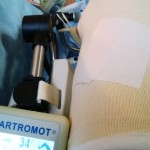
Ho cominciato con il kinetec sabato 25 gennaio 2014 appena arrivato a casa e i primi due giorni (sabato e domenica) mi sono limitato a 30°/35° due volte al giorno per 45 minuti. Dal lunedì le sedute sono diventate tre da un’ora ciascuna sono arrivato gradualmente a 60° giovedì, quindi a una settimana dall’operazione.
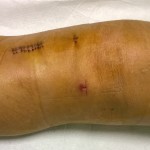
Ecco il mio ginocchio a una settimana: Ginocchio che a detta dell’ortopedico si presentava molto bene, anche se per me era parecchio gonfio e la gamba che fino a una settimana prima era tonica e abituata ad alzare grossi pesi, veramente piccola, quasi biafrana, la prendevo con due mani. Seconda settimana passata sempre sul kinetec per tre sedute giornaliere da un’ora arrivando da 60° per arrivare a 90° il secondo giovedì. Alla fine di ogni seduta ho sempre messo ghiaccio per circa venti minuti. Non ho fatto elettrostimolazione col Compex che posseggo e che è una componente del mio protocollo attuale. Ho rispettato quanto mi ha detto il mio ortopedico, ma ora dove faccio fisioterapia ci sono persone e soprattutto atleti che sono già in palestra a fare fisio attiva e passiva dopo 4 giorni. Sono scelte, ripeto. Ad ogni modo, il secondo giovedì a 14 giorni, mi sono stati levati i punti e sono rimasto con tutore bloccato a 60° e mi è stata tolta una stampella. Infine nella terza settimana, sono arrivato a 120° che è il massimo del Kinetec e ci ero già arrivato il lunedì, quindi in anticipo sui tempi. Ho cominciato a provare a levare completamente le stampelle dentro casa e a caricare sulle scale con passi alternati come se avessi entrambe le ginocchia sane. Visita il mercoledì e conferma di un ginocchio in buone condizioni, con una mobilità ottima per la terza settimana, ma chiaramente ancora molto “duro”. Infatti, bisogna arrivare a piegare si il ginocchio con il kinetec a 120°, ma se uno prova a piegarlo da solo, la cosa deve risultare ancora alquanto difficile. Prima di passare a
componente del mio protocollo attuale. Ho rispettato quanto mi ha detto il mio ortopedico, ma ora dove faccio fisioterapia ci sono persone e soprattutto atleti che sono già in palestra a fare fisio attiva e passiva dopo 4 giorni. Sono scelte, ripeto. Ad ogni modo, il secondo giovedì a 14 giorni, mi sono stati levati i punti e sono rimasto con tutore bloccato a 60° e mi è stata tolta una stampella. Infine nella terza settimana, sono arrivato a 120° che è il massimo del Kinetec e ci ero già arrivato il lunedì, quindi in anticipo sui tempi. Ho cominciato a provare a levare completamente le stampelle dentro casa e a caricare sulle scale con passi alternati come se avessi entrambe le ginocchia sane. Visita il mercoledì e conferma di un ginocchio in buone condizioni, con una mobilità ottima per la terza settimana, ma chiaramente ancora molto “duro”. Infatti, bisogna arrivare a piegare si il ginocchio con il kinetec a 120°, ma se uno prova a piegarlo da solo, la cosa deve risultare ancora alquanto difficile. Prima di passare a  raccontare la prima settimana di riabilitazione a Villa Stuart a fare fisio attiva, vi racconto le tre settimane passate a casa in termini di dolori e funzionalità. La casa dove abito è su due livelli e quindi ho fatto trasportare un letto al piano terra per le prime due settimane, ma considerate che le scale le salivo con le stampelle già dal quarto giorno post operatorio. Onde evitare possibili incidenti ho preferito rimanere al pianterreno e di non andare quasi mai al piano superiore, ma sappiate che nel caso non riusciste ad organizzarvi, ce la potete fare. Per rientrare a casa ho dovuto viaggiare disteso per lungo sul sedile posteriore e le buche si sentivano un po’ nella zona del prelevamento, ma niente di trascendentale. La prima notte a casa che era la terza dopo l’operazione, ero senza l’antidolorifico in vena e ho preso il bufren per bocca tre volte al giorno, per poi scendere a due dal lunedì, una a pranzo e una a cena prima di dormire e vi assicuro che i dolori sono rimasti sotto controllo. Semmai i dolori sono aumentati nella zona della tibia a destra e a sinistra della cicatrice che è rimasta insensibile fino a questi giorni che sono 30 dopo l’operazione. E poi abbastanza dolore sotto la rotula. Ho avuto male a più riprese per tutto questo mese, ma sempre di meno e ad ondate. Dal quinto giorno si dorme decisamente meglio e dalla seconda settimana è tutto in discesa. La doccia non l’ho più fatta fino al lunedì della terza settimana, quindi in diciottesima giornata. Questo è già un lato molto positivo e poi le gambe, per quanto piccole e instabili, cominciano anche se a fatica a risopportare il peso ed ho ricominciato a salire le scale a passo alternato in ventesima giornata e anche a guidare col cambio automatico. Infatti anche se fossi passeggero, una volta che la gamba può essere distesa, farebbe esattamente lo stesso e non devo né frenare, né usare la frizione. C’è da dire che arrivavo da una situazione fisica di iper allenamento e quindi nonostante la mia età , non posso confrontarmi con pazienti che sono in sovrappeso o svolgono una vita sedentaria. Come ho scritto sopra, ogni paziente risponde a modo suo, sappiate che dal primo giorno che sono tornato a casa, le gambe le ho lasciate stare, ma tutto il resto ho ripreso ad allenarlo con i dovuti tempi e modi. Certo facevo e faccio una gran fatica per via dell’indebolimento e il fiato che non c’è più e poi la fatica per proteggere le aree infortunate, ma grazie ad esempio alla mia area addominale e del “core”, riesco a deambulare e a compiere gli esercizi isometrici con estrema facilità e che sicuramente non riuscirei a fare se arrivassi da una situazione pregressa di non allenamento e di sovrappeso. Per quanto riguarda i medicinali, ho preso l’antibiotico per via intramuscolare per cinque giorni due volte al giorno, abbastanza doloroso, poi il gastroprotettore per via orale per dieci giorni, l’antidolorifico fino a quando sopportavo i dolori; io l’ho sospeso in decima giornata e poi la puntura nella pancia di Clexane, 4.000 U.I. per i trombi per venti giorni, una volta al giorno la sera e la calza a compressione anti trombosi che ho indossato per 20 giorni. Ho fatto Kinetec fino a domenica 16 Febbraio 2014 e poi lunedì ho iniziato il protocollo attivo che perdura anche adesso fino a tutta la prossima settimana. Il protocollo prevede Lun/Mer/Ven in palestra a secco con esercizi di isometria e questa settimana che sono a 30 giorni dall’intervento ho aggiunto camminata sul tapis roulant e cyclette, più elettrostimolazione che faccio anche a casa. A casa poi continuo con il P90X ridotto e trazioni alla sbarra con gambe in isometria. Il Mar/Gio, invece sono in piscina, dove svolgo esercizi di mobilità e rafforzamento, con la riduzione della gravità grazie alla presenza dell’acqua. E questo è un ottimo aiuto per ricominciare gradualmente. Ricordate che ora stiamo guarendo e stiamo ripartendo, non possiamo considerarci atleti sani e quindi i muscoli vanno trattati diversamente da un muscolo sano, allenato e ipertrofico come ero abituato ad avere. Ed infatti proprio ieri ho avuto una contrattura all’ischiocrurale che spero si risolva nei prossimi giorni come tale e che non sia una lesione perché questo comporterebbe tempi più lunghi. “Quality over quantity” .
raccontare la prima settimana di riabilitazione a Villa Stuart a fare fisio attiva, vi racconto le tre settimane passate a casa in termini di dolori e funzionalità. La casa dove abito è su due livelli e quindi ho fatto trasportare un letto al piano terra per le prime due settimane, ma considerate che le scale le salivo con le stampelle già dal quarto giorno post operatorio. Onde evitare possibili incidenti ho preferito rimanere al pianterreno e di non andare quasi mai al piano superiore, ma sappiate che nel caso non riusciste ad organizzarvi, ce la potete fare. Per rientrare a casa ho dovuto viaggiare disteso per lungo sul sedile posteriore e le buche si sentivano un po’ nella zona del prelevamento, ma niente di trascendentale. La prima notte a casa che era la terza dopo l’operazione, ero senza l’antidolorifico in vena e ho preso il bufren per bocca tre volte al giorno, per poi scendere a due dal lunedì, una a pranzo e una a cena prima di dormire e vi assicuro che i dolori sono rimasti sotto controllo. Semmai i dolori sono aumentati nella zona della tibia a destra e a sinistra della cicatrice che è rimasta insensibile fino a questi giorni che sono 30 dopo l’operazione. E poi abbastanza dolore sotto la rotula. Ho avuto male a più riprese per tutto questo mese, ma sempre di meno e ad ondate. Dal quinto giorno si dorme decisamente meglio e dalla seconda settimana è tutto in discesa. La doccia non l’ho più fatta fino al lunedì della terza settimana, quindi in diciottesima giornata. Questo è già un lato molto positivo e poi le gambe, per quanto piccole e instabili, cominciano anche se a fatica a risopportare il peso ed ho ricominciato a salire le scale a passo alternato in ventesima giornata e anche a guidare col cambio automatico. Infatti anche se fossi passeggero, una volta che la gamba può essere distesa, farebbe esattamente lo stesso e non devo né frenare, né usare la frizione. C’è da dire che arrivavo da una situazione fisica di iper allenamento e quindi nonostante la mia età , non posso confrontarmi con pazienti che sono in sovrappeso o svolgono una vita sedentaria. Come ho scritto sopra, ogni paziente risponde a modo suo, sappiate che dal primo giorno che sono tornato a casa, le gambe le ho lasciate stare, ma tutto il resto ho ripreso ad allenarlo con i dovuti tempi e modi. Certo facevo e faccio una gran fatica per via dell’indebolimento e il fiato che non c’è più e poi la fatica per proteggere le aree infortunate, ma grazie ad esempio alla mia area addominale e del “core”, riesco a deambulare e a compiere gli esercizi isometrici con estrema facilità e che sicuramente non riuscirei a fare se arrivassi da una situazione pregressa di non allenamento e di sovrappeso. Per quanto riguarda i medicinali, ho preso l’antibiotico per via intramuscolare per cinque giorni due volte al giorno, abbastanza doloroso, poi il gastroprotettore per via orale per dieci giorni, l’antidolorifico fino a quando sopportavo i dolori; io l’ho sospeso in decima giornata e poi la puntura nella pancia di Clexane, 4.000 U.I. per i trombi per venti giorni, una volta al giorno la sera e la calza a compressione anti trombosi che ho indossato per 20 giorni. Ho fatto Kinetec fino a domenica 16 Febbraio 2014 e poi lunedì ho iniziato il protocollo attivo che perdura anche adesso fino a tutta la prossima settimana. Il protocollo prevede Lun/Mer/Ven in palestra a secco con esercizi di isometria e questa settimana che sono a 30 giorni dall’intervento ho aggiunto camminata sul tapis roulant e cyclette, più elettrostimolazione che faccio anche a casa. A casa poi continuo con il P90X ridotto e trazioni alla sbarra con gambe in isometria. Il Mar/Gio, invece sono in piscina, dove svolgo esercizi di mobilità e rafforzamento, con la riduzione della gravità grazie alla presenza dell’acqua. E questo è un ottimo aiuto per ricominciare gradualmente. Ricordate che ora stiamo guarendo e stiamo ripartendo, non possiamo considerarci atleti sani e quindi i muscoli vanno trattati diversamente da un muscolo sano, allenato e ipertrofico come ero abituato ad avere. Ed infatti proprio ieri ho avuto una contrattura all’ischiocrurale che spero si risolva nei prossimi giorni come tale e che non sia una lesione perché questo comporterebbe tempi più lunghi. “Quality over quantity” .
Bene, continuerò a tenervi aggiornati fino a completa guarigione, sperando di farvi cosa gradita e spero che possiate trovare spunto se siete in una situazione analoga. Se avete domande, scrivetemi pure e il proseguo lo farò in articoli nuovi,(qui) anche per avere una lettura più agevole, visto che qui siamo già a quasi 3.000 parole. Naturalmente metterò il link così che possiate ritrovare questo articolo, sempre nelle categorie “Tenersi in Forma” e “infortuni”.
Stay Tuned!
© Copyright Piero Maina – All Rights Reserved









